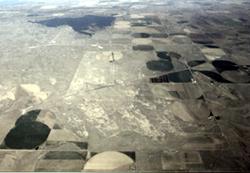
Wheat: Precipitation
Like all plants and
animals, wheat requires water in order to carry on important life processes.
In addition to the direct need for water, water determines the effects of other environmental factors. For example, the
U.S. Environmental Protection Agency (EPA) has discovered that the amount
of precipitation during a growing season can determine
the effects of elevated temperatures on wheat growth. As temperatures
increase, so does the rate of evaporation from the plants and soil. A lack of precipitation during
times of elevated temperatures can have a negative affect on wheat growth.
The high temperatures may cause the limited water that is available to
quickly evaporate. However, if there is abundant precipitation
during periods of elevated temperatures, then
water is available to the plants despite elevated evaporation rates.
 The
EPA has stressed that this model is not a perfect prediction of the future,
especially since water patterns are difficult to predict. However, the
model shows wheat's strong dependence on water. Since there is often not
enough precipitation to provide crops with the water necessary for proper
growth, many farmers must irrigate their land. Photo:
Irrigation structures. Photo courtesy of Steven Croft.
The
EPA has stressed that this model is not a perfect prediction of the future,
especially since water patterns are difficult to predict. However, the
model shows wheat's strong dependence on water. Since there is often not
enough precipitation to provide crops with the water necessary for proper
growth, many farmers must irrigate their land. Photo:
Irrigation structures. Photo courtesy of Steven Croft.
On the other hand, it is possible to have too much precipitation. If the wheat is too wet, it cannot be harvested because it will clog up the machines. If the wheat is dry but the fields are saturated with water, the wheat still cannot be harvested because the heavy machinery used to harvest it will get stuck in the muddy field. The longer mature wheat remains in the field, while the farmer waits for proper harvesting conditions, the more susceptible the crop is to damage. Two common sources of damage to wheat crops in extremely wet conditions are bacterial disease and fungal growth. Both of these can severely decrease wheat yield.
Overview
..|..
Nutrients ..|..
Temperature
..|..
Precipitation
..|..
Carbon
Dioxide
Glossary ..|..
Related
Links ..|..
References
|..
PBL
Model
Home ..|.. Teacher Pages ..|.. Modules & Activities
HTML code by Chris
Kreger
Maintained by ETE
Team
Last updated November 10, 2004
Some images © 2004 www.clipart.com
Privacy Statement and Copyright © 1997-2004 by Wheeling Jesuit University/NASA-supported Classroom of the Future. All rights reserved.
Center for Educational Technologies, Circuit Board/Apple graphic logo, and COTF Classroom of the Future logo are registered trademarks of Wheeling Jesuit University.
